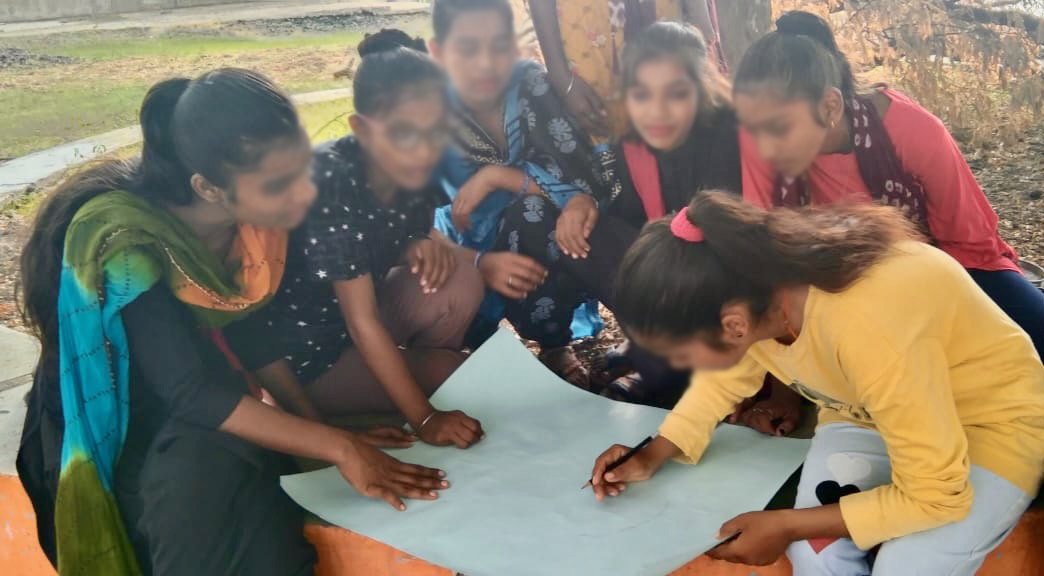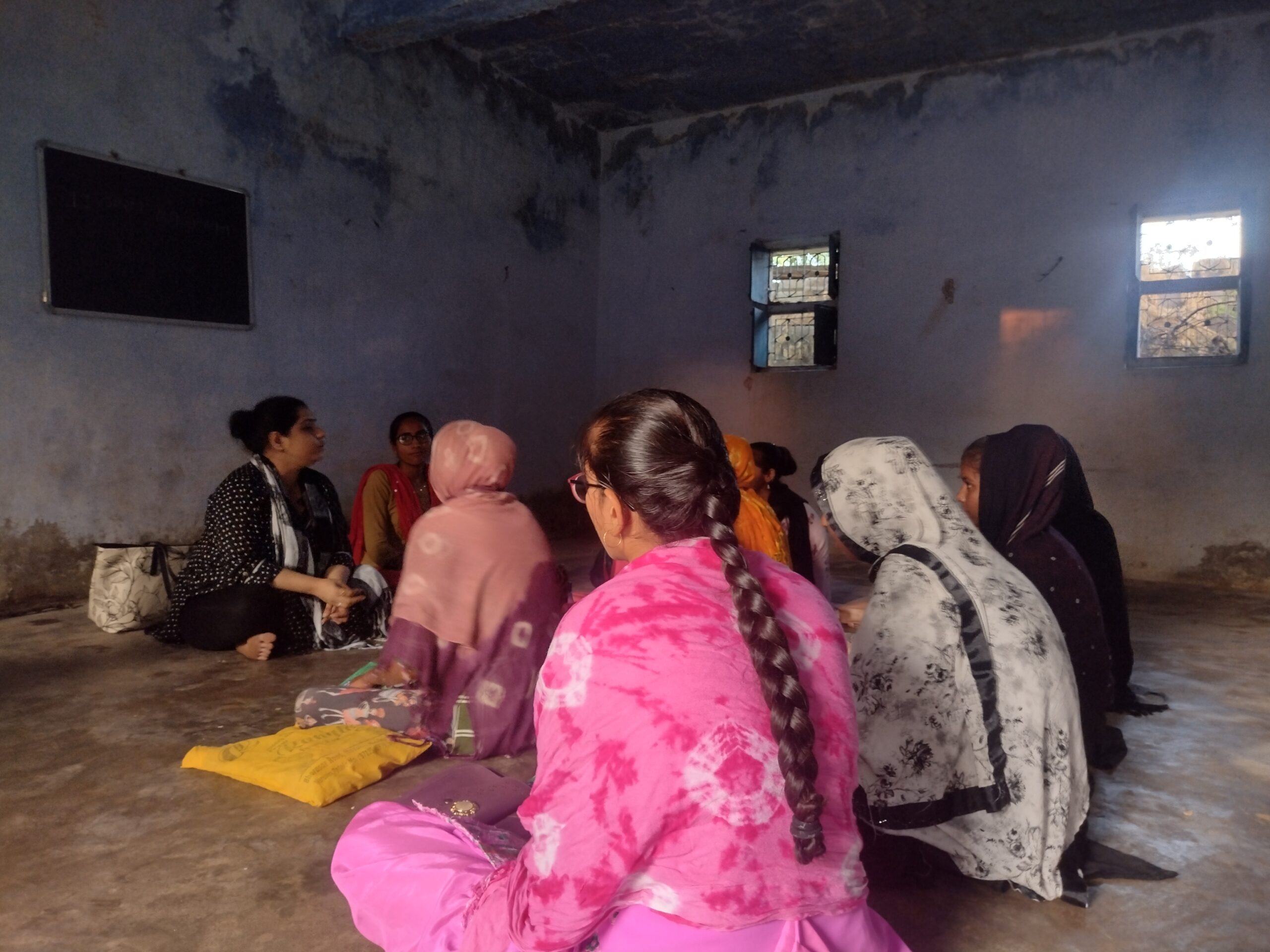In the last couple of months, I had been accompanying a team of mental health professionals from MPower Foundation (Mumbai) on their mental health awareness sessions in Kutch. These sessions were primarily being held with children and adolescents in schools and Akhar Centres (tuition centres run by KMVS for children who have dropped out of school) in parts of Kutch where KMVS works.
On this particular day, we were running behind schedule due to delays in the previous sessions. The next session was in Nangiari, a village in Bhuj block, at one the Akhar Centres. The class usually concludes by 5pm. However, owing to our delay, we extended past this time. The session was going well.
The girls were actively responding to the facilitator especially when they were asked to write down everything that had troubled them that day, and then tear the paper into as many small pieces as they could. Perhaps it was my bias, but they all seemed to be extra enthusiastic and animated in tearing the page.
Shabnam, the teacher in charge of that Akhar Centre, was visibly tense. She quietly reminded us of the time more than once. We finally ended the session around 6:10 pm, followed by a brief selfie session on the request of girls.

As we were preparing to leave, a woman in her late 30s walked briskly towards us. She approached our vehicle’s window and firmly kept her hand on the sill. She was evidently upset with us for keeping the girls till late. For the next 15 minutes, she stood there and expressed her displeasure. Even though she spoke in broken Hindi and Gujarati, we understood her annoyance and anger. A kind of anger so smug that it mocked.
“Ladki ko itna padhake kya hoga? Sarkari naukri karegi? Panchayat chalaegi?”
“Karni toh shaadi hee hai, dusre ka ghar chalana hai”
A heavy silence enveloped our car as we departed. Hearing tales of girls being held back from pursuing education or venturing outside at their will is one thing. But being reminded me of my own teenage self, feeling powerless against a parent’s wrath, was quite another.
This incident shouldn’t have been so shocking for me and my colleagues because we come across such experiences quite often. After this, for the past few months, we had been running a campaign in rural Kutch. It is called Ek Sanjh Mari Sanjh (An Evening for Myself). It aims to initiate conversations with girls and young women about gender inequity, through focus on mobility and leisure.
Some questions that we ask to delve into the underlying societal norms – What’s the farthest you’ve ever traveled from home? Which spots in your village do you frequent the most? Which spaces do you avoid? For how long can you stay out? Are you free to go out for any reason as you please? Do other people in your house also follow the same rules? If not, why are they binding on you?

Mobility & Gender
“To speak of mobility is to speak of gender,” my mentor once told me. Here I’m using the term ‘mobility’ to denote the freedom to move effortlessly and without restrictions from place to place irrespective of one’s identity (sex, religion, gender, class, caste, age etc.)
The question of whether mobility influences gender norms or the other way around, would be similar to that of the age-old chicken and egg debate or the nature versus nurture argument. The messy reality is that it goes both ways. While gendered socialisation, especially during the transition to adolescence, along with the imposition of gender roles, stereotypes, safety concerns, and agency, influences one’s mobility, one’s choices about destination, time, purpose, and mode of travel also reinforce gender inequities in broader social systems.
These inequities manifest in the opportunities accessible or available to women, primarily in employment (hence, economic agency) and education, but also in terms of sexual expression (clothing, body language). Besides these, leisure and hence intent and choice also come into play. Often, I hear girls say that it’s okay if they go out for work or to run errands. But not to a friend’s place or to roam around aimlessly unless there’s a social event. And certainly not after dark ie. past 5 pm in winter and 7 pm in summer. In some communities these restrictions start as early as 2pm.
I recall how another time, during a campaign with a large group, a mother dragged her daughter home at 5pm. She was shouting, “What will your father say?”. Later, a colleague confirmed my suspicions. The mother was more afraid of being scolded by her husband for letting their daughter stay out until late, than being concerned of her daughter being out at 5 pm.
Mobility, Education & Employability
In the context of adolescent girls and young women of Kutch, one of the biggest barriers the lack of mobility creates is in their education. The village schools rarely teach beyond class 8, leaving the high schools outside the village as the only option but they are at least 8 km away. Those whose family can afford and allow them to go out, go to community or government run residential schools at the nearest hub. Others just get left out. The lack of public transportation also hinders them. Coupled with societal expectations of care work, designated gender roles and general lack of support, only a few make it to the 9th standard. Boys typically have the option of riding a bike to school, if they want to.
This becomes an impediment to a girl’s employability. Those who are unable to finish school don’t make it to college and hence, miss out on acquiring knowledge and skills. This limits their options, opportunities and prospects of earning livelihoods. Moreover, the mobility barriers come in the way of going out to work. Many young women in the village take up work in tailoring, bridal make-up and teaching. This allows them to work from home or nearby home so that they can return before evening.
I got to listen to the story of two young girls close to my age, who used to work full-time jobs at non-profit organizations in Bhuj. They had completed college education and they lived in a village an hour away from Bhuj. But the commute took longer due to infrequent buses and the long walk home from the highway. They would return only around 8 pm. The reason for taking up these jobs was to support their families and make the best of their education. However, their relatives and neighbours soon started to gossip and pass comments on their safety and character, eventually convincing their otherwise supportive parents to restrict their movement.
Mobility & Spaces
Where would you go if you had an evening to yourself? To do as you please?
Girls expressed willingness to go to a range of places, from the main street of the village itself, a lake nearby, a mandir or dargah, to even a serene spot in nature right outside the village. Some even wished to play in the streets outside their house, after sunset. The time of the day significantly affects their mobility. The same spaces where girls walk safely during the day, are off limits after dark especially if they are poorly lit.
Most public spaces would be exclusively occupied by men, making then unheard of and unseen for women. At times, men drinking alcohol also frequent these places, away from the plain sight of the village. This makes them even more dangerous for girls and women.
Mobility & Play
Playgrounds, also places to express these desire for adolescents, are unfortunately, aren’t easily accessible either. In Mindiyana, the girls voiced that they wanted to play cricket. During the campaign, they got together and negotiated with the boys, to schedule time separately for girls to use the field. Even with this arrangement, they faced initial resistance. The boys troubled them in various ways during their allocated playtime.
At a recent ‘Theatre of the Oppressed’ I conducted at a school, I saw how play is gendered. When asked to make an image of playtime, a group of boys showed a match of cricket. However, when a girl suggested changing it to kho kho, the boys scoffed. To them, Kho kho is a ‘girly’ game.
Also read: ‘Theatre Of The Oppressed’ As A Tool For Social Change
After speaking with them, I learnt how play becomes the first ground on which we, as a society, place barriers to mobility. It is around the age of 12, when puberty hits, that girls playing in public, regardless of the game, becomes frowned upon. Restrictions on clothing and cycling also emerge. Even when pre-pubescent girls play, it is usually with other girls only, and sports like cricket or football rarely feature in these groups. Alongside these barriers come constraints on sexual expression and bodily autonomy. Play becomes the multifaceted sphere in which these issues manifest.
Mobility, Leisure, Intent, Purpose
At its core, playing is recreation and leisure, fundamental human need. Just as I was starting to perceive the barriers to women’s and girls’ mobility as inflexible, designed solely to confine them within patriarchal bounds, someone corrected me. It was slightly strange for me to learn that girls aren’t stopped from moving, provided there’s a clear purpose approved by others. Like visiting the market, going to a relative’s place nearby with an agenda, attending school, going to work, heading to farmland, or participating in social events like weddings.
In fact, many of them travel outside their village for daily wage jobs at large factories, commuting via company buses or pick-up trucks. However, if a young girl wishes to simply hang out at a friend’s place, loiter without any reason, or sit in a public space, the restrain enters. At the same time, if she’s visiting a friend’s house for an engagement party, she’s welcome to do so. A clear intent becomes crucial. It becomes evident that in the process of curtailing mobility, personal autonomy is also snatched.
An interesting thing to note is the exceptions. There is freedom to stay out late for garba during Navratri, sometimes until 3 am or even next morning. Even the most rigid social constructs have their loopholes of flexibility. The saree or ghara choli in this case, comes to mind at the blink of an eye.
Thus mobility becomes a crucial marker and a corner stone of the empowerment of women. While a large chunk of online conversations on the topic centre around transportation, street lights, and presence of police, the story here in Kutch begins much earlier, within the threshold of one’s home. A meticulous combination of mobility, agency, autonomy and voicing will perhaps yield the desired outcomes. Till then, everything from education, employment, choice of clothing, maintaining a healthy circle of friends, or simply indulging in a harmless stroll, continues to remain beyond reach for these girls.
References:




If women decided to loiter around the common spaces, wouldn’t the issue of permission based mobility decrease? But it is still the chicken and egg problem!